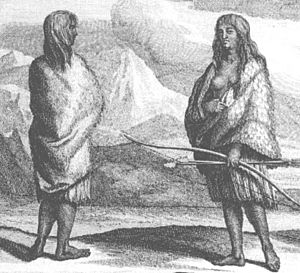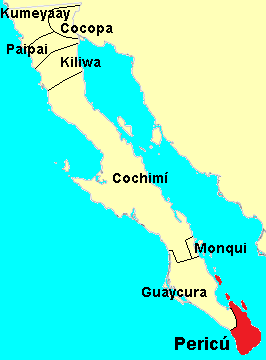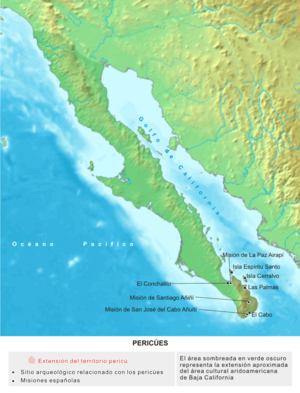Pericúes facts for kids
The Pericú people were the first inhabitants of the Cape Region, which is the very southern tip of Baja California Sur, Mexico. They were also called Pericues, Cora, or Edues. Sadly, their language and culture disappeared by the late 1700s.
Contents
Where the Pericú Lived
The Pericú people lived in the southern part of the Baja California Peninsula. This area stretched from Cabo San Lucas in the west to Cabo Pulmo in the east. Their territory also included several large islands in the Gulf of California. These islands were Cerralvo, Espíritu Santo, La Partida, and San José.
Some experts, like William C. Massey, thought a group called the Cora lived in the eastern part of this region. However, later studies suggest that "Cora" was just another name for the Pericú people.
The area around La Paz was a bit tricky. It might have been a place that both the Pericú and another group, the Guaycura, fought over for a long time.
Pericú Language
We don't know much about the Pericú language. Only a few words and place names have been recorded. Jesuit missionaries, who came to the area, said that Pericú was a different language from Guaycura. Some people thought they were related because they lived close to each other.
Ancient Pericú History
Scientists have found signs of people living in the Pericú territory for at least 10,000 years. This goes back to a time called the early Holocene period. Some unique skulls found in the Cape Region suggest that the Pericú ancestors might have come from across the Pacific Ocean. Or, they could be descendants of some of the very first people to settle in the Americas.
A special way of burying people, called the Las Palmas complex, was common here. It involved painting bones with red dirt and placing them in caves. The Pericú also used old hunting tools like the atlatl (a spear thrower) and darts. They used these even when most other North American groups had switched to bows and arrows. This shows how isolated and unique their culture was.
Around the year 1000 AD, four main centers became important in the Cape Region. These were near Cabo San Lucas, at Cabo Pulmo, in La Paz, and on Isla Espíritu Santo.
Pericú History with Europeans
Europeans first met the Pericú people in the 1530s. This happened when explorers like Fortún Ximénez and Hernán Cortés arrived in La Paz. Over the next two centuries, the Pericú had many encounters with Europeans. These included explorers, pirates, missionaries, and pearl hunters. Sometimes these meetings were friendly, and sometimes they were not.
The Jesuits built their first permanent mission in Baja California at Loreto in 1697. But it took them more than 20 years to set up missions in the Pericú area. Missions were built at La Paz (1720), Santiago (1724), and San José del Cabo (1730).
A big event was the Pericú Revolt in 1734. This was the most serious challenge the Jesuits faced in Baja California. Two missionaries were killed, and the Jesuits lost control of the Cape Region for two years. However, the Pericú people suffered the most. Many died in battles, and even more died from diseases brought by the Europeans. By 1768, when the Spanish government removed the Jesuits, the Pericú culture had mostly disappeared.
Pericú Way of Life
We know about the Pericú's traditional way of life mostly from what early European visitors wrote down. English privateers, who spent time at Cabo San Lucas in the early 1700s, left some of the most detailed descriptions.
Food and Tools
The Pericú were known for their strong connection to the ocean. They caught fish, collected shellfish, and hunted marine mammals from the waters of the southern Gulf of California. They also gathered plants like agave and cactus fruit. Small animals and deer from the land were also important for food. They did not practice farming.
The Pericú were one of the few groups on the California coasts who used wooden rafts and double-bladed paddles for water travel. Most others used simple reed boats. They used nets, spears, harpoons, darts, and bows and arrows to get food. They carried things in bags, baskets, and gourds, as they did not make pottery. They needed very little clothing or shelter, but women wore skirts made of plant fibers or animal skins. Both men and women liked to decorate themselves.
Community Life
Work among the Pericú was divided mainly by gender and age. Some reports say they had one partner, while others say they had multiple. Each community seemed to be independent. Leaders inherited their positions, and sometimes women held these roles. There were often wars between different communities and with the neighboring Guaycura group.
Beliefs and Spirituality
Some stories about Pericú beliefs were written down in the early 1730s. Shamans (spiritual healers) claimed they could use special powers to cure sick people. Funerals and mourning ceremonies were very important and detailed.
The Pericú believed in a powerful creator named Niparaya, who made the sky and earth. His wife was Amayicoyondi, and they had three sons. One son, Quaayayp, created humans but was later killed by them. The other sons were Acaragui and Wac (or Tuparan).
See also
- Las Palmas complex
- In Spanish: Pericú para niños




